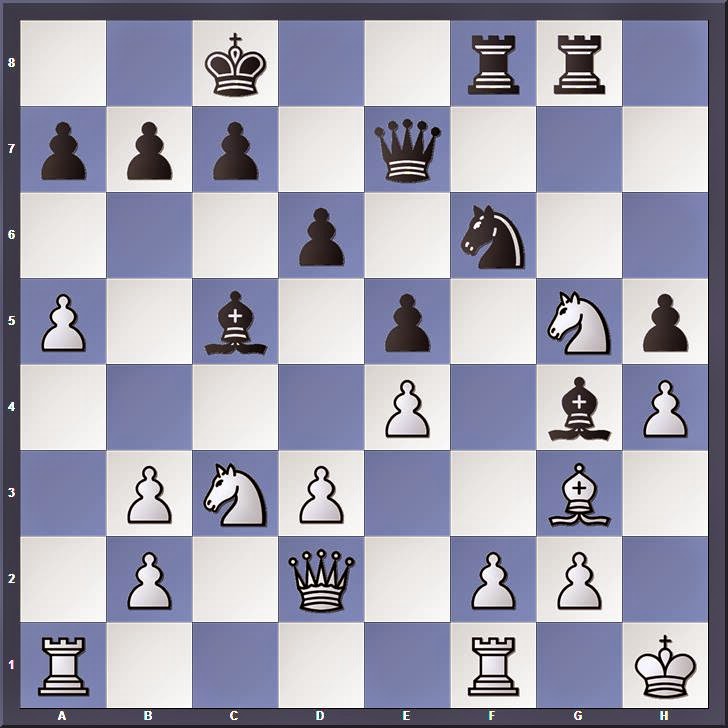Wilhelm Steinitz offered a pawn to Serafino Dubois in their game during the London International Chess Congress, 1862. Johann Lowenthal comments in the tournament book that Dubois "was not to be tempted" (The Chess Congress of 1862 [1864], 102). I was less keen to the dangers while I was reviewing Dubois -- Steinitz in the early morning last week and proceeded to play this move against Hiarcs on the iPad. I lost, but not in a manner that confirms the general consensus concerning the dangers.
Dubois -- Steinitz begins:
1.e4 e5 2.Nf3 Nc6 3.Bc4 Bc4 4.O-O d6 5.d3 Nf6 6.Bg5?! h6 7.Bh4 g5 8.Bg3
At this point, we have Middle Game Position 168 in GM-RAM: Essential Grandmaster Knowledge (2000) by Rashid Ziyatdinov, which I have been working through since December (see "Game of the Week").
Black to move
 |
| GM-RAM Position 168 |
8...h5!
Steinitz offered a pawn here.
Nineteenth century commentators and Stockfish 6 agree that 9.h4 is best, and that is what Dubois played. ChessBase database has eleven games with 9.Nxg5--all Black wins. The statistics certainly seem grim for snatching the pawn.
The earliest game is Knorre -- Chigorin, St. Petersburg 1874.*
Knorre,Victor -- Chigorin,Mikhail [C50]
St Petersburg, 1874
1.e4 e5 2.Nf3 Nc6 3.Bc4 Bc5 4.0–0 Nf6 5.d3 d6 6.Bg5 h6 7.Bh4 g5 8.Bg3
Diagram above.
8...h5 9.Nxg5 h4 10.Nxf7 hxg3 11.Nxd8 Bg4 12.Qd2 Nd4
White to move
13.Nc3
There are two games in the ChessBase database with 13.h3. Another game referenced in T.D. Harding and G.S. Botterill, The Italian Game (1977) is absent from this database.
13...Nf3+ 14.gxf3 Bxf3 0–1
Ashley -- Tollit, Birmingham 1923 continues from the diagram with 13.h3
13.h3 Ne2+ 14.Kh1 Rxh3+ 15.gxh3 Bf3# 0-1
This is the game played more recently on at least two occasions (1996 and 2005).
Perhaps, 14.Kh1 is the critical error, however, in this last example. White could have played
14.Qxe2!.
Black to move
After 14...Bxe2 15.Ne6, Black still appears to have an edge, but checkmate no longer seems imminent.
Although the database offers only losses for White after 9.Nxg5, engine analysis of these miniatures and of my play against the iOS version of Hiarcs leaves me wondering whether capturing the offered pawn is a mistake, as asserted by Lowenthal.
James Stripes -- HIARCS [C50]
Spokane, 31.03.2015
1.e4 e5 2.Nf3 Nc6 3.Bc4 Bc5 4.0–0 d6 5.d3 Nf6 6.Bg5 h6 7.Bh4 g5 8.Bg3 h5
Position from Dubois -- Steinitz, 1862
9.Nxg5
Black to move
9...Bg4
9...h4 is the critical line in most commentaries. 10.Nxf7 Qe7 11.Nxh8 hxg3 12.Kh1 with an advantage for Black
10.Qd2 Qe7
10...h4
11.Bxf7+ Kd7 12.h4
12.Bh4 might be better.
12...Raf8 13.Bb3
13.Bc4
13...Kc8 14.Nc3 Bb6 15.a4 Bc5
White to move
16.a5
16.Nd5 with a two pawn advantage, I should seek to exchange pieces.
16...Nd4 17.Kh1 Nxb3 18.cxb3 Rhg8
White to move
19.f4
19.a6 may be better, as is 19.f3.
19...Bd7 20.fxe5 dxe5 21.Bf2 Kb8 22.Na4 Bxf2 23.Rxf2 Ng4 24.Rxf8+ Qxf8
White to move
25.Qe2?? Qf4 0–1
Difficult positions provoke errors. On the other hand, a move cannot be deemed an error merely because it invites difficulties. It may be possible to learn to defend such a position. Having an advantage of two pawns often is worth something.
*See Edward Winter, "Confusion," Chess Notes (updated 14 March 2014) for another early instance of this game, and for discussion of problems regarding the game score of Dubois -- Steinitz 1862.




















No comments:
Post a Comment